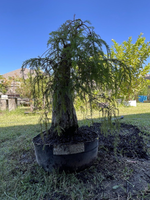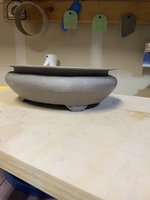mwar15
Omono
I have used the blue glaze before but not on this clay. I like how dark it is. I’ll have to make some more
You should but then again I'll have more blue pots.I have used the blue glaze before but not on this clay. I like how dark it is. I’ll have to make some more
26x5” I made for @Cajunrider. A few photos and how tight it was in the kilnView attachment 531031View attachment 531032View attachment 531033
@Cajunrider oh my... that is a BIGGGGG pot! Show us the tree you had in mind for this bad boy26x5” I made for @Cajunrider. A few photos and how tight it was in the kilnView attachment 531031View attachment 531032View attachment 531033
It is none other than Franco Columbo. While large the pot is delicate. I am making a support slab to ensure a flat surface for the pot to rest on top.@Cajunrider oh my... that is a BIGGGGG pot! Show us the tree you had in mind for this bad boy

Going to be awesome! Love the 'lie^u~ ru~' feel of Franco.It is none other than Franco Columbo. While large the pot is delicate. I am making a support slab to ensure a flat surface for the pot to rest on top.
Franco is budding right not. He is going to flex his handsome branches soon.
View attachment 531170
The photo is. The overall dimension was after firing.That's prefire right?
Sorce
Potters often use temporary supports for firing, either made from the same clay dried at the same time, or small piles of a sand mixture. You can often see some fumed round marks on the base of a pot where they were. The best Chinese pots of old have small "sesame seed" marks on the base where they were supported.Is there a good reason that pots, especially this size, don't have extra feet in the middle of the bottom to help support the weight of the tree? Small pots don't need them, and extra tall feet would make them visible but large low pots like these seem like it could reduce sagging during firing, and stress on the slab bottom too
Potters often use temporary supports for firing, either made from the same clay dried at the same time, or small piles of a sand mixture. You can often see some fumed round marks on the base of a pot where they were. The best Chinese pots of old have small "sesame seed" marks on the base where they were supported.


How big is the granite pot?View attachment 540471View attachment 540472View attachment 540473View attachment 540474A few fresh out of the kiln
5.5x3.5x2”How big is the granite pot?
Oh bummer, I thought it was a big one. Nice pot and love the color and the granite look. We have lots of granite around here.5.5x3.5x2”
